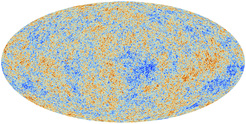21.03.2013
The universe is older than previously assumed
The Big Bang occurred 120 Million years earlier than previously assumed, this appears from data of the Planck-Mission, today released by the European Space Agency (ESA) in Paris. The Planck Collaboration presented the first all-sky map of the cosmic microwave background radiation. The oldest light in the universe was emitted when the universe was only 380,000 years old and became transparent for the first time. The „primordial soup“ of protons, electrons and photons cooled gradually, allowing neutral hydrogen atoms to form and the light to escape. As the universe continued to expand and to cool, this radiation was shifted to longer wavelengths, so that it is received today as cosmic microwave background (CMB) at temperatures of about 2.7 Kelvin. Tiny temperature fluctuations in this CMB map reflect smallest density fluctuations in the early universe.
"This Planck CMB provides us with an extremely detailed picture of the early universe", says Simon White, Co-Investigator in the Planck Collaboration, director at the Max Planck Institute for Astrophysics (MPA) and principle investigator at the Excellence Cluster Universe. Planck was designed to measure these fluctuations across the whole sky with greater resolution and sensitivity than ever before, allowing scientists to determine the composition and evolution of the universe from its birth to the present day.
"The Planck data fit extremely well with the standard model of cosmology", says Torsten Ensslin of the MPA, who is managing Germany's participation in the Planck mission. The analysis of the Planck data show that normal matter contribute only about 4.9 % to the mass and energy density of the universe (4.5 % assumed so far). About 26.8 % is dark matter, contributing far more than previously assumed (22.7 %). Dark energy, the mysterious component that causes the universe to expand ever faster, on the other hand, accounts for only 68.3%, less than expected (72.8 %). Finally, the Planck data also set a new value for the rate at which the Universe is expanding today, known as the Hubble constant. At 67.15 km/s/Mpc, this is significantly less than the current standard value in astronomy (72 km/s/Mpc). The data imply that the age of the Universe is 13.82 billion years.
However, because the precision of Planck’s map is so high, it also revealed some peculiar unexplained features, which cannot easily be reconciled with the standard model. One of the most surprising findings is that the fluctuations in the CMB temperatures at large angular scales are not as strong as expected from the smaller scale structure revealed by Planck. Another is an asymmetry in the average temperatures on opposite hemispheres of the sky. This runs counter to the prediction made by the standard model that the Universe should be broadly similar in any direction we look. Furthermore, a cold spot extends over a patch of sky that is much larger than expected. This data could point to an extension of the standard model or even new theories.
Further information
Press release of the Max Planck Gesellschaft
Information of the ESA






